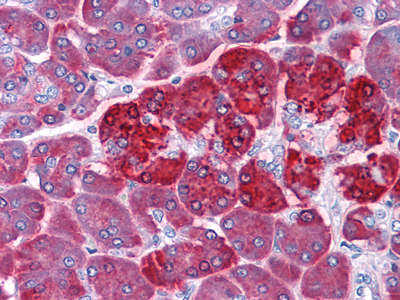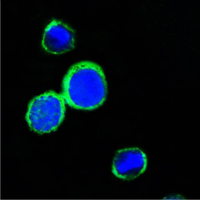Reg Iα Monoclonal Antibody
- Catalog No.:YM0555
- Applications:IHC;IF;ELISA
- Reactivity:Human
- Target:
- Reg Iα
- Gene Name:
- REG1A
- Protein Name:
- Lithostathine-1-alpha
- Human Gene Id:
- 5967
- Human Swiss Prot No:
- P05451
- Immunogen:
- Purified recombinant fragment of human Reg Iα fused with hIgGFc tag expressed in HEK293 cell line.
- Specificity:
- Reg Iα Monoclonal Antibody detects endogenous levels of Reg Iα protein.
- Formulation:
- Liquid in PBS containing 50% glycerol, 0.5% BSA and 0.02% sodium azide.
- Source:
- Monoclonal, Mouse
- Dilution:
- IHC 1:200 - 1:1000. IF 1:200 - 1:1000. ELISA: 1:10000. Not yet tested in other applications.
- Purification:
- Affinity purification
- Storage Stability:
- -15°C to -25°C/1 year(Do not lower than -25°C)
- Other Name:
- REG1A;PSPS;PSPS1;REG;Lithostathine-1-alpha;Islet cells regeneration factor;ICRF;Islet of Langerhans regenerating protein;REG;Pancreatic stone protein;PSP;Pancreatic thread protein;PTP;Regenerating islet-derived protein 1-alpha;
- References:
- 1. Pancreas. 2004 Jul;29(1):14-21.
2. Int J Cancer. 2008 Jul 15;123(2):409-13.
- Background:
- This gene is a type I subclass member of the Reg gene family. The Reg gene family is a multigene family grouped into four subclasses, types I, II, III and IV, based on the primary structures of the encoded proteins. This gene encodes a protein that is secreted by the exocrine pancreas. It is associated with islet cell regeneration and diabetogenesis and may be involved in pancreatic lithogenesis. Reg family members REG1B, REGL, PAP and this gene are tandemly clustered on chromosome 2p12 and may have arisen from the same ancestral gene by gene duplication. [provided by RefSeq, Jul 2008],
- Function:
- caution:The composition of the O-linked carbohydrate on Thr-27 is complex and varied. In the crystallographic structure, the attached sugar appears to be N-acetylglucosamine, typical of an intracellular protein, rather than N-acetylgalactosamine.,developmental stage:High expression levels in fetal and infant brains; much lower in adult brains.,disease:Alzheimer disease and Down syndrome patients show enhanced expression of PSP-related transcripts and intraneuronal accumulation of PSP-like proteins in their brains.,function:Might act as an inhibitor of spontaneous calcium carbonate precipitation. May be associated with neuronal sprouting in brain, and with brain and pancreas regeneration.,online information:Lithostathine A,similarity:Contains 1 C-type lectin domain.,tissue specificity:In pancreatic acinar cells and, in lower levels, in brain.,
- Subcellular Location:
- Secreted.
- Expression:
- In pancreatic acinar cells and, in lower levels, in brain. Enhanced expression of PSP-related transcripts and intraneuronal accumulation of PSP-like proteins is found in brain from Alzheimer disease and Down syndrome patients.
- June 19-2018
- WESTERN IMMUNOBLOTTING PROTOCOL
- June 19-2018
- IMMUNOHISTOCHEMISTRY-PARAFFIN PROTOCOL
- June 19-2018
- IMMUNOFLUORESCENCE PROTOCOL
- September 08-2020
- FLOW-CYTOMEYRT-PROTOCOL
- May 20-2022
- Cell-Based ELISA│解您多样本WB检测之困扰
- July 13-2018
- CELL-BASED-ELISA-PROTOCOL-FOR-ACETYL-PROTEIN
- July 13-2018
- CELL-BASED-ELISA-PROTOCOL-FOR-PHOSPHO-PROTEIN
- July 13-2018
- Antibody-FAQs
- Products Images

- Immunohistochemistry analysis of paraffin-embedded human Pancreas tissues with AEC staining using Reg Iα Monoclonal Antibody.

- Confocal immunofluorescence analysis of PC12 cells using Reg Iα Monoclonal Antibody (green). Blue: DRAQ5 fluorescent DNA dye.



